Eamon Loingsigh's Blog, page 19
October 3, 2013
October Update
Hello and thanks for coming by. Happy October!
This is a monumental month in getting the word out about  Light of the Diddicoy, the first book in the Auld Irishtown trilogy. Over the River PR has literally sent 100 advance review copies of the book to reviewers like the New York Times Review of Books, Los Angeles Review of Books, Salon.com, The Millions and so many more.
Light of the Diddicoy, the first book in the Auld Irishtown trilogy. Over the River PR has literally sent 100 advance review copies of the book to reviewers like the New York Times Review of Books, Los Angeles Review of Books, Salon.com, The Millions and so many more.
Also, review copies were sent to individuals who may be able to break into the big reviewers and are interested in the topic this historical novel covers. Lit blogs like Levi Asher‘s LitKicks and famous writers like TJ English and Mary Pat Kelly also are being sent copies as well as Irish-American periodicals/websites Irish Central and The New Wild Geese.
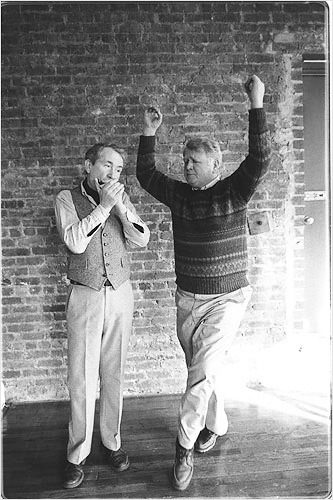
Frank (left) & Malachy McCourt were often seen on stage in New York together performing “A Couple of Blaguards.”
In one of the biggest events of late, I received a phone call from Malachy McCourt about the book. Mr. McCourt, as most of you know, is the brother of Frank McCourt, who has since passed, but was winner of the Pulitzer Price for his 1996 memoir, Angela’s Ashes. I have always been a big follower of Malachy McCourt’s work, however, especially his A Monk Swimming and his work alongside his brother on the stage with A Couple of Blaguards. Malachy mentioned that Light of the Diddicoy is written in a poetic voice and that he had already read through half of it in just a day or so.
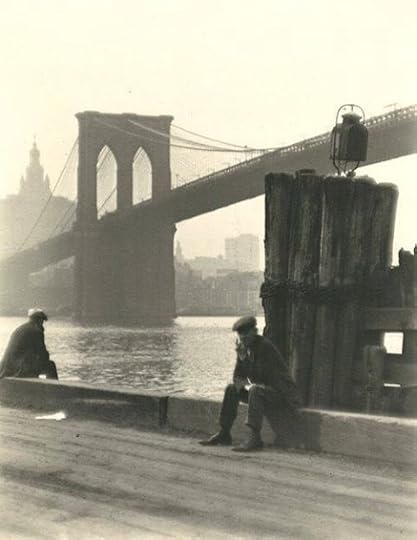
We have a goal of 1,000 “Likes” by the end of October for the Facebook Light of the Diddicoy Fan page. Come by and see it here: https://www.facebook.com/artofneed
After a conference call with Over the River PR, I was encouraged to create a Facebook fan page for Light of the Diddicoy. If you are on Facebook, please come by and “Like” it. Then, share it, if you would! It will have a lot of great information about the run-up to the book’s release come March, next year.
If you know of someone who would be interested in reviewing the book for a newspaper, magazine, website or blog, do not hesitate in getting in touch.
Things are really looking great for the up-coming release and there seems to be growing excitement surrounding the story. It’s truly part of the American lore. The “Immigrant Story,” symbolic of the struggle and incredible pressure our ancestors had to overcome in the Old Country and in the new.
Again, here’s the Facebook fan page: https://www.facebook.com/artofneed
Eamon


September 12, 2013
Cassidy & Irish Street Slang
It is well known that for many, many years, the Irish in America were seen as second class. They were laborers, house maids and lived barely above the status of slaves. Often, because of their Catholicism, they were treated worse.
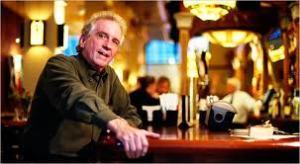
Daniel Cassidy, author of “How the Irish Invented Slang” at a bar in New York City.
Irish-Americans have come a long way since then, but there are still some things that have yet to be fully unearthed within the Hibernian/Gaelic culture separate from the Anglo-Saxon/English culture. Of course, there are not many things more relevant when talking about culture than language, for which the Irish has a long and successful history, whether oral or with the pen.
In 2007, a book supported by a left-leaning publisher (CounterPunch) did much to open the flood gates to the great influences the Irish had on the English language in the United States. And with this Irish pride came the old Anglo-American discriminations that were once so powerful in the form of the Know-Nothing Party, policies against hiring Irish at the workplace and the Nativist burning of Catholic churches in America.
When Daniel Cassidy’s How the Irish Invented Slang: The  Secret Language of the Crossroads came out, the research behind it was called “casual, off the cuff.” And that there was “no scholarship or real evidence at all in it.”
Secret Language of the Crossroads came out, the research behind it was called “casual, off the cuff.” And that there was “no scholarship or real evidence at all in it.”
It’s premise was called “baloney,” yet in the end, we have found the only baloney was the lack of research into the influence Gaelic-Irish had on the English language by the supposed diligent dictionary-makers like Oxford and the Anglophile American versions such as Merriam-Webster.
“Daniel Cassidy flings down the gauntlet to all those compilers of dictionaries who fled to the safe haven of ‘origin unknown’ when confronted with the challenge of American slang,” said Joseph Lee, Professor of Irish Studies at New York University.
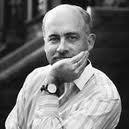
Peter Quinn is an Irish-American Historian, author of “Banished Children of Eve” and was an advisor to Martin Scorsese on the film, “Gangs of New York.”
“He has brought back to life that which was considered dead and settled,” said Historian Peter Quinn.
“Imagine old, sunken roads re-surfaced on our maps,” Publisher Alexander Cockburn said.
Even as the cloistered British professors and American Anglophiles tried disassembling Cassidy’s evidence, the research ended up becoming a breakthrough that stifled the English language protectorates. These Oxfordonians would much rather avoid admitting any influence on the English language such as slang that came from the tenant farmers in Ireland that were exiled to American cities like Boston, Philadelphia and New York where, on the city streets, the secretive slang of rebels and thieves reached up into daily usage.
When the How the Irish Invented Slang won the 2007 American Book Award for nonfictional, it was settled. Although some research still needed to be done to have multiple sources, it was established that the Irish language had had a profound and previously undocumented influence on the English language.
Unearthed by Cassidy’s studying of a Foclóir Póca, or Irish-English pocket dictionary along with the skills produced by studying the language and history of the Irish in his position at the head of the Irish Studies program at New College of California, Cassidy uncovered lingual gems such as the word “crony.”
pocket dictionary along with the skills produced by studying the language and history of the Irish in his position at the head of the Irish Studies program at New College of California, Cassidy uncovered lingual gems such as the word “crony.”
Previously, the Merriam-Webster Dictionary speculated that the word crony came from Greek etymology, but Cassidy points out that it comes from the Irish comh-rhogna (pronounced co-rony) which means “fellow favorites,” used often in and around Tammany Hall and the poker tables of the port cities where the Irish traditionally worked as longshoremen and laborers.
The perfect translation from the Irish to the English seems obvious for words like “crony,” even to those who have never studies linguistics. Combine that with the old cultural discrimination and refusal of all things Irish by British and Anglo-American rule makers, and today’s culture of empowered political correctness and How the Irish Invented Slang became a wonderful controversy for all those who questioned HL Mencken, author of The American Language, when he said the Irish had contributed very few words, “Perhaps speakeasy, shillelagh and smithereens exhaust the list.”
Mr. Cassidy’s work was groundbreaking (Here he is talking about his book). But it didn’t all come from research and study, it also came from his own family. His growing up in an Irish Catholic home in New York City had a lot to do with it too. In fact, much of his research at the New College of the University of California had to with genealogy. For Cassidy, whose lineage was traced back to the Irish Famine of the 1840/1850s and subsequent emigration to America, it was personal.
“Even growing up around it, little shards of the language stayed alive in our mouths and came out as slang,” Cassidy told the New York Times (NYTimes review linked).
As a child, he was nicknamed “Glom.” When he asked why Glom, his family responded, “because you’re always grabbing other people’s stuff.” (Here he is talking about being called Glom)
Glom or glaum in English translates as “glam” in the Irish and means “to grab, to clutch, to grasp.” Which now is obsolete in English, but was once used regularly, as in this April 15, 1912 San Francisco Bulletin article, “It may have been the Easter season… but tis a fact, ‘Chic’ Hartley actually broke through his shell yesterday and glommed a couple of hits.”
In researching Light of the Diddicoy, the first book in the Auld Irishtown trilogy, I uncovered many fascinating things about my own Irish background and how separate and different a culture Irish-Americans truly had from the incumbent Anglo-Americans. But nothing was as astonishing to me as the influence of the Irish language on American street slang. It opened my mind to the voice of the narrator of my book, Liam Garrity, and had a profound affect on the way his story needed to be told, the words that he would have used circa 1915/1916 and the underscoring of the underground nature, or anti-establishment and anti Anglo-Saxon culture of Irish-Americans.
In fact, I found some of the words in Cassidy’s work being used by real gang members of the era in the many newspaper articles and police reports I sifted through. Finding out that these words, which were so embedded in the American city street language had Irish origins, for me, was amazing:
Stool pigeon English – “a police informer,” Irish (steall beidean) – “a falsely accusing informer”
Growler English – “a can used to carry fresh beer home from a saloon,” very popular in New York, Irish (gearr-ol ur) – “a fresh quick drink,.”
Spalpeen English – “a common workman, scamp” Irish (spailpín) – “itinerant farm worker, scamp”
Dude English – “a dapper dandy,” Irish (dud) – “a foolish looking fellow,” which explains how the poor Irish immigrants saw the rich Americans. “Dude” is still in affect today, however it means “a regular guy,” which falls between the variants.
Shanty (Irish seantigh) “an old house”
Ballyrag (Irish bollaireacht) “a boaster, a bully”
Slugger (Irish slacaire) “to beat or hit hard,” think: Babe Ruth, 1920s
Racket (Irish raic ard) “a loud uproar”
Helter Skelter (Irish Ailteoir seaoilte) “an uncontrolled wild prankster”
Ground Sweat (Irish grian suite) “a grave”
There are so many more that I simply cannot name them all, although I left a list of a few below to interest you.
The fact remains today that, even as we continue to confront old and outdated discriminations on many fronts, we still have so much more work to do. Even though it is 2013, we still have women in the working place making less than men, African-Americans grossly outnumbering whites in prisons and American Hispanics still not being accepted within the culture.
After winning the American Book Award, Mr. Cassidy died of cancer. It was a great loss, but what hurts even more is that his work has not been taken up by another university and no scholarship or funding has been secured by Irish-American organizations to continue this valuable research.
“It’s unfortunate,” Peter Quinn explained in an email to me. “But as far as I know no one has continued with Danny’s explorations. Danny was the first to say that his work was meant as a beginning rather than an end. He was eager to start a group project but died before it could get underway.”
Baloney – Béal Ánna, “silly, foolish talk”
Boss – Bás, “boss, best, very good”
Brag – Bréag, “a lie, exaggeration, deception”
Cop – Ceap, “a protector or chief.” The verb “ceap” has meanings including to catch or intercept.
Daddy – Daidí
Gab – Gab, “a chattering mouth”
Goon – Guan
Hick – Aitheach, meaning a peasant, a churl
Jazz – Teas, meaning heat, passion, excitement
Lucre – Luach Áir, “reward of gold
Shack – Teach, “house”
Eighty-six (as in remove, like from a menu) – Eiteachas aiocht “denial, refuse”
Slob – Slab, “dirty or slovenly person”
Smashing – ‘s maith sin, meaning “it is good”
So long – Slán
Buddy – Bodach, “a clown, churl”
Drag (as in race) – De raig, “sudden acceleration”
Poker – Poca, “pocket game”
Jack (as in money) – Tiach, “a small purse, money”
Finagle – Fionna aclai “an ingenious invention, contrivance”


August 30, 2013
Longing Eyebrows
I, for one, can’t wait. When the time longs into my soul and the creak in my knees cause gentle steps, I’ll grow long my eyebrows. I’ll let them loose on my face as I chase away the last days of my living.
Now I stand though. I have son and daughters rearing up on me. Smiling as they gain to overtake me.
Today is the day a great poet died. And nothing’s warmer in the throat than the poet that you have long smiled with in word. From the long life he gently stepped and with such great care. So thoughtful that it was oft he was for granted taken.
‘til now.
The sound of the subway sizzling in a whoosh through the long tunnels brings me back to my grandfather too. Another man of the gentle hand who so gives me the light of hope for my long eyebrowed salute to this life. He held my hand in the traincar for he knew the surroundings were new on me. Dark colors around, spray paint clicking sounds splayed upon each wall and passing train, ca-click-ca-click-ca-click went swooshing through my cotton-wool brain.
My grandfather rarely talked. By trade, he was a listener. And there had been in this life nothing that once he had not heard sung by the throats of men whetted with liquor in the old west of Manhattan saloon in our family.
“Who are the Mets playing today?” asked I.
“The Astros.”
“Houston Astros?”
He nodded in smile at me, tapped the top of my hand on my knee.
“Jose Cruz is on the Astros. I like his stance.”
“Really? How so?”
“Uh, he just has a, uh, it looks cool.”
“Cool?”
“Yeah, like it’s a fluid motion.”
“A fluid motion? That’s a wonderful way of explaining it.”
“Yeah, it’s just a fluid way of swinging. Like he has an artistic way of swinging and I can imagine him hitting the ball square while, um, before he has even swung yet. Do you know what I mean?”
“I do, I do. Much better now, I understand.”
The lights flick on and off and we speed through the click of the black tunnels as he smiles from above. His dear hands and the touch which became so familiar to me, I couldn’t see then, but was the touch of a poet who’d never once been named so. He’d not written much words in his long years and his work was that of hearing the spirits sway in his mind like the Latin prayers of his own youth, sweeping in Mass along the echo of another era long since left.
I have a picture of him when he was yet a young soul. It’s dated 1919.
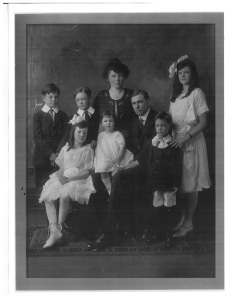
My grandfather on the right with his eldest sister’s hands on his shoulder.
I look upon it now and remember that train ride in 1979, when I was that age.
“Haven’t you ever seen him play before?” I asked.
“I suppose I have, but never quite saw him as I do now.”
It was an afternoon game, warm on the skin. We sat in the sun and I looked over the expanse of the place and with the smell of the wind and the green of the grass on my nose, my mind was set on a pace. The grass now so welcome a smell with the clickety-clack of rust out of the way, yet the Met fans did not see it in such a way.
“Ya bum!”
“Ya’re a friggin’ louse! Go back to da minors!”
And when Jose Cruz hit a long shot that swooped across my eyes in the sky, headed down with a reaching carry, I stood up with the rest of the crowd but for another reason. I was taken by the swing of him while the color of the blue and white uniforms, the yellow and orange uniforms, the green of the grass, the colorado of the infield left the place, overcome with a whooshing, resounding “BOOOOO!”
Darkening my thoughts, he stood by me and looked down, seeing too the color of my face leaving it. The sadness of the whole world rising in the chant of disgust and blasting down into me like a wave smacking my eyes and face.
“What a beautiful swing!” he yelled in my ears above the mad crowd.
I kept my mouth closed and looked up at him with the smile of a child once understood. He who was a lifelong Brooklyn Dodgers fan turned New York Mets fan found my little thoughts truer than any loyalty to his team.
I had never heard him raise his voice before. And I never heard him raise his voice again. The only time worth doing so, was then, I suppose.
“In the gloom you cannot trace a wrinkle on their beeswax brow,” he said, after the crowd laid down their insults and we all sat back in our stadium pews.
I listened, then looked away. A few pitches later when the urgency of the words left us, I asked what he meant by them.
He smiled, “Could mean anything. That’s the beauty of poetry and of religion. It means what you make of it.”
“Can you say it again, I don’t remember it perfectly.”
“In the gloom you cannot trace a wrinkle on their beeswax brow.”
“Who is ‘they’?”
“Poor women in a city church.”
“Oh.”
“You can think about it long, but it only means what you make of it.”
The distant thud of ball in catcher’s mitt fell far away. The anger of the crowd too, many years away. Here I sit writing as I may of the death of a great poet that in my childhood found a way to open my thoughts to the many, many things they can possibly convey.
“What is the name of that person who wrote that?” I asked my 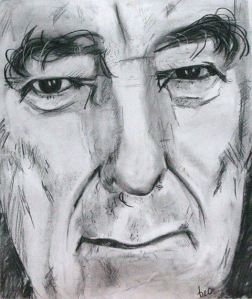 grandfather.
grandfather.
He smiled and looked down at me again, tapping his familiar hand on the top of my own, “Seamus Heaney.”
Eamon Loingsigh, 8/30/13


August 27, 2013
August Update
Well, I just wanted to give an update on where we are with Light of  the Diddicoy (pre order now, if you like), the first book in the Auld Irishtown trilogy. I’d like to plan on sending these at least once per month until the big day, March 17, 2014.
the Diddicoy (pre order now, if you like), the first book in the Auld Irishtown trilogy. I’d like to plan on sending these at least once per month until the big day, March 17, 2014.
For all those people that are giving this a book a chance, I just wanted to give a great big ‘THANK YOU.’ It is truly amazing what has been going on. I’ve basically been plucked from nowhereville, to having a publisher with a huge distributor, a public relations company and riding the wave of a previous author who has already proven himself as a success writer.
Three Rooms Press has invested in this project, and for that I am truly humbled and owe a great debt of gratitude. I have always thought of myself as being true to my word, so hopefully I will get a chance to show my gratitude in the future with Three Rooms Press. I have always been skeptical of the motives of publishers, but TRP has literally undermined that notion with their actions, the best way to show intentions.
truly humbled and owe a great debt of gratitude. I have always thought of myself as being true to my word, so hopefully I will get a chance to show my gratitude in the future with Three Rooms Press. I have always been skeptical of the motives of publishers, but TRP has literally undermined that notion with their actions, the best way to show intentions.
Here are a couple reasons why I feel this way:
I was very surprised when it was announced that they had hired Perseus as the distributor for my book. Perseus is a top distributor in the industry with connections to every library, bookstore, website, anywhere you can think of a place you would want your book to get noticed, Perseus is there.
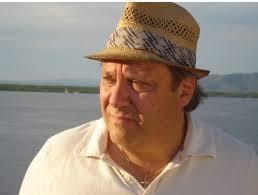
Mr. Vetere’s new book, The Writers Afterlife, is also due out in March of 2014.
Second, a public relations company was hired in a two-for-one deal for both Light of the Diddicoy and Richard Vetere‘s next book, The Writers Afterlife. So, not only do I get signed on to a public relations company, but on the back of a proven author, playwright and screen writer who has worked with some of my all time favorites like Francis Ford Coppola, Martin Scorsese, Walter Matthau, Ed Harris and has even been reviewed by Michiko Kakutani in the NY Times Book Review!
Somewhere above 200 galley copies (advanced review copies) of the book are going to be sent out everywhere and if I’m lucky, it’ll get reviewed by the big kids on the block and picked up by major bookstores and hopefully book readings all over the place, including Ireland! In short, getting the word out!
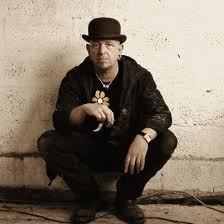
Guy Denning is an English artist (with Irish roots) who lives in France and regularly has shows in Paris galleries.
Many of you already know that Guy Denning, a very popular artist living in France, did the cover art for Light of the Diddicoy. Well, I was finally able to see what the artwork looks like on the book and let me tell you, it is amazing. I was planning on keeping the artwork a secret for another month or two, but it’s already up on amazon.com, so I posted it above. There have been loads of compliments and I am very proud of the work Mr. Denning created. He latched onto this project even before I had a publisher and read a rough draft copy of the book when he decided to do the artwork. How many artists would do such a thing as that? so I have a big debt of gratitude to Mr. Denning as well for seeing into the future (I guess that’s what artists do though).
On the back cover, where other authors write about the book in a “blurb,” there is a 19th Century Brooklyn street map surrounding the Brooklyn waterfront close to the Navy Yard and Vinegar Hill, where the book takes place.
It’s all like a dream coming true. I am very excited and I hope you are too.
The email list for this blog has recently taken a big leap and we are now close to 3,000. Many of you requested to be added, others are family members and friends that will watch this project grow and, hopefully, on St. Patrick’s Day next year when the book is released, see it blossom into its own beauty.
Thank you so much,
Eamon


August 13, 2013
Whitey Bulger Book Review
Well, the trial has been going on for quite a while now, but finally a  verdict is in. Whitey Bulger has been convicted in his hometown of South Boston.
verdict is in. Whitey Bulger has been convicted in his hometown of South Boston.
During the days of his gangsterism, Boston Globe journalists Kevin Cullen and Shelley Murphy covered the story. It took them all over the country, but what they uncovered was not only gruesome and nefarious, but amazing in the fact that a man could live the life of an Irish-American gangster in the late 20th Century. How did he do it? Come check out this book review. But I’ll give you a hint: The FBI helped him.
What I’m looking forward to is feedback from Whitey himself. I found that he has an opinion of almost every book and article written about himself. I don’t know if he still has access to such things, but hey Whitey, let me know what you think.
Eamon


August 6, 2013
An American Writing in Hibernian
“The Irish accent has
beaten its French
counterpart
as the world’s sexiest.”
~The Telegraph (British newspaper)
I was so immersed in the story of Liam Garrity, Dinny Meehan and the White Hand Gang, that my personal life was suffering. I was missing appointments, forgetting important topics at work and lost in thought among the demands of everyday life. The first draft of Light of the Diddicoy was complete, but it lacked the immersion I felt within my imagination. What existed in my mind didn’t come through well enough on paper. The complete and overwhelming realities of the life of a 14 year-old farm boy from Ireland suddenly thrust into the rough-cobbled neighborhoods of Brooklyn’s waterfront gangs was missing the link that brings together a writer’s imagination and the reader’s perception of the story.
What I needed was something tangible that would bring the reader directly into the tensions Liam, the immigrant protagonist faced while forced to work as a longshoreman, then going homeless, being brought into a gang where fist-fighting was a measure of one’s worth and the terrible decision between family and survival.
As all writers do, I consulted some of the greatest works that did to me what I wanted to do for my readers. Bring her/him into a life where decision-making was entirely influenced by survival. A young Irishman in the big American city.
There are many works that influenced the voice of Liam Garrity in Light of the Diddicoy, but in the end I needed to come up with my own voice for him. And after the first edit of the rough draft, I was keenly aware that I’d really only put together a written outline of the story at that point. It was filled with information that was not essential to the flow of the story. The most important part was yet to come: The Voice.
I decided to strip down the informational aspects of the story, what I called the “explanation” of it, and replace it only with direct “experiences.” I even named the edit, “X-for-X.”
That was the first part of the edit, which left out some details of the characters’ backgrounds and a better understanding of the background of the gang, but with two other books (it’s a trilogy, remember) and with loads of “experiences” still in store for young Liam, I felt safe that eventually they’ll get covered.
The next part was something I’ve always been interested in. My entire life I have been fascinated with accents, dialects, speech impediments and the sentence structure of those who speak my first language, as their second language: English.
Although many books influenced Light of the Diddicoy (I simply 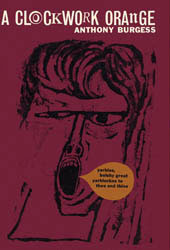 cannot start naming them all off), I found A Clockwork Orange to be a brilliant story that had an powerful effect on me (I even dressed up like ‘Alexander the Large’ for Halloween one year), due mostly to Anthony Burgess’s amazing ability to put together Russian-inspired words with English street slang and rhyming slang that he called “Nadsat.” The first-person narration made me feel as though I was within the story myself. Although I identified with Alex’s (narrator) mischievous nature, the fact that the language was so new and experimental made me feel like I was actually a part of the story, even though I read it thirty years after its original publication.
cannot start naming them all off), I found A Clockwork Orange to be a brilliant story that had an powerful effect on me (I even dressed up like ‘Alexander the Large’ for Halloween one year), due mostly to Anthony Burgess’s amazing ability to put together Russian-inspired words with English street slang and rhyming slang that he called “Nadsat.” The first-person narration made me feel as though I was within the story myself. Although I identified with Alex’s (narrator) mischievous nature, the fact that the language was so new and experimental made me feel like I was actually a part of the story, even though I read it thirty years after its original publication.
Other books and stories that experimented with language also electrified my imagination. But, wanting to keep the story of Liam as the universal struggle of the immigrant, particularly the Irish immigrant, I decided to study the Irish language. Then I narrowed it down again to Hiberno-English, and then pared it down again to the Hiberno-English of the nineteen-teens.
There are all kinds of derivative accents and dialects in Light of the Diddicoy including the Brooklyn accent as opposed to the other New York borough accents, a Kilkenny dialect (Paddy Keenan), Irish-traveler’s (Tommy Tuohey), a Dubliner’s (Patrolman Brosnan) and even Cockney-Irish (Sadie Meehan) and a Jewish-German (Abe Harms) accent. But the most important dialect is the storyteller himself, Liam Garrity, who grew up on a farm in County Clare and lived in Brooklyn the rest of his long life.
Hiberno-English, of course, is the language of a country that had learned a foreigner’s tongue due to conquest. Strict respect to English grammatical rules was not a priority, though many of the grammatical rules of Irish-Gaelic often apply to an Irish person’s use of the English language.
I won’t go into great detail of the idiosyncrasies and syntax of Hiberno-English, but some of the most easily recognizable traits are fun to look at. One of the first things I learned that made me both laugh and think about why I had never noticed it before, was the fact that the Irish rarely ever use the word “yes” or “no” in English. There simply were not words for these two opposing adverbs in Irish. Therefore, you’ll find when an Irish person is asked a simple yes-or-no question, like:
“Are you fond of apples?” He or she may reply simply, “I am.”
“Do you hate Americans?” You might ask her/him.
“I don’t, but the Brits can go feck themselves altogedder.”
Which brings me to another fun point, reflexive pronouns such as “herself” and “himself” within the Irish vernacular. You can see it in this example of one girl asking another if she went somewhere, with a hint of jealousy behind it.
“Did you bring yourself to the show then?”
Instead of those from England or the United States who might ask, “Did you get to go?” (because I couldn’t go).
The use of a reflexive pronoun here indicates an influence from the Irish-Gaelic grammar.
And of course, you have ’tis.
“Beatiful day ’tisn’t.”
“’tis, ’tis.”

Colin Farrell, whose Irish accent and handsome face make him one of the sexiest men in the world. He might do well as Dinny Meehan too in a film adaptation, I’d think.
The lilt, or brogue of the Irish is the accent that is so recognizable. It was recently voted in a poll of over 5,000 women worldwide to be the sexiest (I had to pull the quote above from an British newspaper for good measure).
This is no surprise. Americans and the world-over love everything Irish. Especially the beer and whiskey on St. Patrick’s Day, which is when Liam Garrity and his West of Ireland dialect makes his big debut as the narrator in the first book of the Auld Irishtown trilogy, Light of the Diddicoy.


July 10, 2013
The White Hand Gang
There has been some confusion about the gang that is featured in the Auld Irishtown trilogy. And rightfully so as there is a lot of misinformation available on the internet. So, I thought this might be a good time to give a quick history and an outline on what and who the White Hand Gang was.
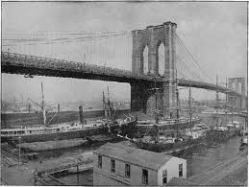
A collection of old ships and piers underneath the Brooklyn Bridge during the 19-teens.
There were a number of gangs along the waterfront in Brooklyn during the early 1900s. The Swamp Angels, who were based on the Lower East Side and were mostly eradicated by the year 1900, often operated as East River pirates on the Brooklyn side. The Red Onion Gang hung out around Warren Street and the Atlantic and Baltic terminals and Dinny Meehan was an original member of this collection of fist-fighting youths.The Jay Street Gang were based, obviously, on Jay Street underneath the Manhattan Bridge. And the Navy Street Gang were known as Camorra Italians by the Navy Yard.
This loose collection of gangs that often fought against each other and the many other nameless gangs of the time are the origins of the White Hand Gang.
If you look on Wikipedia, you’ll see an outline of what the gang was, but I would be careful in taking that information to the bank. Some of the so-called facts on that page cannot be verified and are based on a few trashy biographical fictions that took extreme liberties with the truth. Namely, a book by William Balsamo and George Carpozi Jr. called “Crime Incorporated.” In this book, the Irish-American White Hand Gang’s existence is only part of a fictionalized Mafia rise via the author’s convenient imagination. Entire characters and scenarios are literally made up in order to sensationalize the Italian rise in New York and a war between the Irish and Italians, which never truly existed, ended with the Irish getting beaten. Some of it is based on true stories and actual people, but some of it can never be confirmed through research.
In real life, the White Hand Gang existed as did many street and dock gangs of the time, for multiple reasons. What made them different was their ability to continue to exist as a street gang long after the era of street gangs had ended. The only way this could have occurred is due to a few factors.
They had a very strict code of silence, way more powerful than the Italian Omerta, according to some. They never gave information to the police and kept disputes among themselves to be settled outside of the law.
They lived in Brooklyn, not Manhattan, which means essentially that because Manhattan was considered the real New York City (to some) where international investors and the owning class lived, the police and laws were more strictly enforced, whereas the Brooklyn waterfront was much more of a working class, factory town.
Many of the White Hand Gang members came from Manhattan originally because they sought to continue living in the “old way,” instead of pretending to be legitimate while running illegal operations undercover. So, many of them already knew how to run a street gang due to their experiences and traditions in old Manhattan.
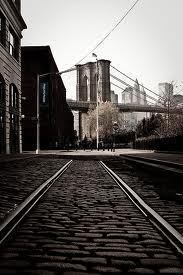
A relatively newer pic, but I love how it shows the old freight rail tracks down Water Street with the Brooklyn Bridge in the distance. This was literally where the gang ran its operations from.
One of the earliest mentions I ever found of the White Hand Gang was from 1905, where four teenagers (17 & 18 years of age) with Irish-American surnames, were arrested for “beating up badly” three other boys on the corner of Hoyt and Warren streets. One of the boys, John Gibney, was arrested for tearing a gas pipe from a saloon wall and lighting it with a match inside a Sands Street saloon, which caused a great fireball. Another was arrested earlier in the week for being drunk and disorderly.
In 1906, Dinny Meehan and a few others were arrested for setting off firecrackers by a bum who had passed out on the platform of an elevated track and causing general havoc.
One member of the White Hand Gang was arrested in 1908 for stealing through a “coal hole” in the sidewalk, gaining access to the basement of a tenement, then breaking into rooms and taking objects of limited value and selling them at a local pawn shop. He was caught because he was covered in coal soot.
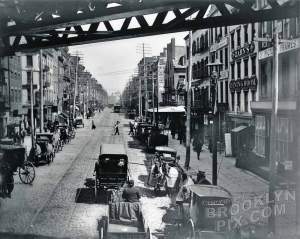
A typical street scene in Brooklyn during the pre-Prohibition era. A look from underneath an Elevated Train track, or “El” down a long street with tenements on either side and bustling human traffic of many immigrants from many ethnic backgrounds.
By most accounts, they were just a collection of jobless, restless teens during the years before 1910, although they had much higher aspirations. The reason they named the gang the “White Hand,” was to counter the Italian “Black Hand” rise. Black Hand, of course, was only a description of the methods Italians used, such as kidnapping for ransom, but the many newspapers of the time thought it was an actual gang. In any case, the Irish-Americans in the dock neighborhood and slums from the Navy Yard all the way down to Red Hook, which were traditionally Irish-held areas since the Potato Famine of the 1840s and 1850s, didn’t want the Italians to move up from their strongholds of Bay Ridge, Bensonhurst and Coney Island and take over the rackets.
This is where Dinny Meehan’s legend is made. None of the plethora of Irish-American gangs in the area wanted to work with another gang from another street. No matter if the majority of all gang members were Irish-American, each gang defended their street like tribal and communal warriors. It would take a great communicator to bring all the Irish-American gangs together to fight against the rise of Italian influence.
Dinny Meehan was such a man. Originally from the Warren Street Red Onion Gang, Meehan eventually became known as the leader of the White Hand Gang and in 1912 when he was 23 years old, his status as leader was cemented when he was exonerated in a sensational trial against him and three of his minions for killing one Christie Maroney, a yegg, bartender and safe cracker who refused to pay tribute to the White Hand Gang before being shot between the eyes at a Sands Street saloon.
At the trial’s conclusion when the verdict was to be read “a large squad of policemen and many detectives and reserves” were summoned as the judge and police felt that if Meehan were to be convicted, a riot would break out at the Kings County Court. The courtroom was packed with young, experienced Irish-American thugs and their girlfriends and Italian leaders like Frankie Yale and Johnny Torrio watched too, hoping he would be convicted.
When the jury decided there wasn’t enough proof or witnesses and Meehan was released, the courtroom and the street outside erupted in cheers and Dinny Meehan was made into a legend, for it is bucking and flaunting the system that has always transformed an Irish-American into a legend in the slums of Brooklyn and beyond.
From that point forward, the White Hand Gang ruled with an iron fist and with extraordinary unity, which as mentioned before was always so difficult for the Irish-American gangs to succeed at. Their power was so fierce and all encompassing in Brooklyn that a young Al Capone was sent to Chicago, as many sources confirm, because the White Hand Gang had him on a short list of those that needed to be killed. In reality, it was one of a few reasons for Capone’s moving to Chicago, but it was certainly true that the White Hand Gang was as powerful, if not more powerful, than the Mafia in Brooklyn at the time and Capone was too hot of a prospect for the Italians to risk.
So, to Chicago went Al.
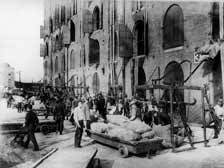
Men working at the Empire Stores, which was a collection of warehousing units primarily for tobacco and coffee. It still exists today, though only as a shell. But I have heard of plans to renovate them.
Under Meehan, the dockboss at each terminal paid tribute to him at 25 Bridge Street. Every laborer that was used to unload or load a ship or truck or freight rail had to first report to Dinny Meehan under the Manhattan Bridge. If a factory or warehouse in the neighborhood (like the Empire Stores warehousing units) refused to pay tribute, Meehan and the boys would steal from it. If a ship captain didn’t pay tribute, people like “Cinders” Connolly, one of Meehan’s men, would set it ablaze and loosen its ties to the pier bollards, letting it burn in the East River where all would watch. If a gang member talked too much, he’d be found in his bed with a gunshot to his face or with his hands tied behind his back in the New York Harbor. The gang was also hired as “starkers,” a term that is basically outdated today, which meant that, for example, the International Longshoremen’s Association (ILA) might hire the White Hand Gang to kill or maim a New York Dock Company employee who refused to pay their union dues. Or, by contrast, the New York Dock Company might hire the gang to kill a particularly obnoxious ILA man.
In any case, with Meehan as the leader, things were organized. Everyone knew who to go to when they needed a job or needed someone killed. Everyone knew what the rules were and the penalty for breaking them.
But, as Irish lore tells us, a leader of men will always be taken down from within, by his own followers.
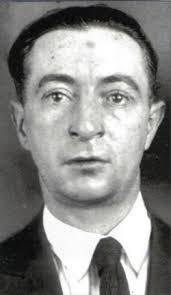
Wild Bill Lovett in a mug shot. He was a wily man who was a decorated World War I veteran and murderer. His mother wanted him to become a priest in the Irish tradition, but having grown up on Catherine Street on the Lower East Side of Manhattan where the Yake Brady Gang taught him how to survive, it was too late for young Bill to turn his morals around.
“Wild” Bill Lovett was five years younger than Dinny Meehan, and at the beginning of Prohibition in 1920, he started spreading ideas about getting in on the up-and-coming bootlegging and illegal distillery boom (an Irishtown tradition). He was a talented gangster with a wild temper when drunk, very intelligent sober. On top of that, he was a decorated veteran of the First World War. Something that gave him a powerful status of his own among the longshoremen gangsters, laborers and factory workers along the Brooklyn waterfront.
Suddenly, the White Hand Gang that had enjoyed so much success and underground notoriety under Dinny Meehan from 1912 to early 1920 had two heads.
In the afternoon of March 31, 1920, among great changes in the underworld’s environment where many older-generation gangsters and organized criminals were being murdered and replaced with new, young turks, Dinny Meehan was shot multiple times while in bed with his wife Sadie, who was wounded in the shoulder. No one was charged for Meehan’s murder, but most everyone knew it was Wild Bill Lovett that either carried it out, or ordered it.
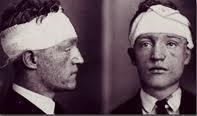
Richard “Pegleg” Lonergan, was run over by a trolley when he was eight years old and lost a leg. He became heir to the White Hand Gang throne when his younger sister Anna married the gang’s leader, Bill Lovett. After Lovett was murdered, “Richie” took over what was left of the dock gang.
From that point forward, chaos reigned within the White Hand Gang. Factions still loyal to Meehan attempted to murder Lovett many times and lower level Whitehanders made hits against each other in a tit-for-tat civil war. When Richard “Pegleg” Lonergan joined forces with Bill Lovett, his childhood friend from the Lower East Side, while at the same time the Meehan-faction’s chosen successor, Garry Barry had his throat slit with a razor in 1922, Lovett finally wrested control.
Although Lovett was on top, he soon wanted out after he married Anna Lonergan, Pegleg’s sister. The Lovett’s moved to Ridgefield Park, New Jersey and power was left to the volatile Pegleg Lonergan. But one night in November 1923, Lovett couldn’t resist and got drunk with his old buddies down in Brooklyn and by the end of the night, he was shot in the neck and bludgeoned to death and Pegleg Lonergan was now king of the dock gang.
During Lovett’s reign, however, the gang’s income had greatly decreased. The ILA had made great offers to care and protect the wages of the working man, Italians had taken complete control of the bootlegging racket, the police had tightened their grip in the area and the gang had been splintering due to Lovett’s drinking habits and lack of discipline. By the time the twenty two year-old Pegleg Lonergan took it over in late 1923, the White Hand Gang was a shell of what it was during the Meehan era of the mid-late 19-teens. No longer did the gang have the respect of the stevedoring companies, the ship owners, the factories and manufacturing plants or the immigrant longshoremen who had traditionally gone to the gang’s headquarters at 25 Bridge Street to pay the “boss” a stipend in order to get a day’s work in. They were essentially back to the way they were before 1912.
Then, on Christmas night, 1925, Lonergan and two of his followers were shot dead in an Italian hangout called the Adonis Social Club. Two others were wounded. Rumor has it that Al Capone was there. And it is true that he was arrested and questioned for the triple murder, since he was in town for his son’s surgery. The fiercest Italian criminal of all time, who was once banished from Brooklyn by the Irish-American White Hand Gang, had now exacted his revenge and essentially put the gang into the history books.
After Lonergan’s murder, the gang became even less prominent and one gang leader after another took the helm only to get promptly murdered.
In December of 1927, a man named Eddie Lynch, a member of the “old Lovett gang” was shot because, as the article stated, he was trying to get the old gang back together again and name himself the leader.
In January of 1928, John “Non” Connors was shot and killed at a bar on Warren and Bond streets by Helen Finnegan. Connors was said to be the gang’s leader, but Ms. Finnegan exerted her own revenge as Connors had killed her brother, James “The Swede” Finnegan a year earlier.
On November 5, 1928, a man named Eddie McGuire had apparently won leadership of the gang with a roll of the dice and immediately afterward was shot and killed. Of all the White Hand Gang’s leaders, his term was the shortest: Five minutes, according to the Brooklyn Daily Eagle.
On January 28, 1930 Red Donnelly, a 50 year old man and veteran of the Meehan era took control and was then killed in a pierhouse on the Columbia Line Pier, shot in the back.
Later in 1930, a man named Jimmy Murray, an old Lovett lieutenant was shot and left for dead after he named himself leader of the Whitehanders.
Finally, in 1931, Matty Martin, who had married Anna Lonergan-Lovett a few years after Bill Lovett’s murder, was killed after he thought he was owed the leadership of the gang and took control of what was by then nothing more than a collection of drunks and drug addicts. He was found slumped over a stoop off Dekalb and was killed, according to reports, due to the declining income of the gang.
By the late 1930s, it was only Anna Lonergan that was still talking about the White Hand Gang’s heyday in Brooklyn, though she never spoke nicely of Dinny Meehan since he was an enemy of her first husband, Lovett. To this day, Bill Lovett is considered the most famous leader of the gang. Richie “Pegleg” Lonergan will always be known as having the coolest White Hand Gang moniker and additionally is known for being killed by Al Capone.
But it was Dinny Meehan that made the White Hand Gang what it was. He was the most organized of the three main leaders (Meehan, Lovett, Lonergan) and certainly the most consistent. He did what so many other gang leaders failed in doing: Bringing the wild Irish “bhoys” to work as one. And his death in 1920 signaled the beginning of the end of the White Hand Gang.


June 18, 2013
NYC Turn of the Century Gangs
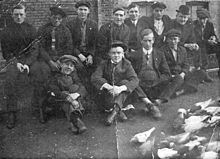
The Gopher Gang circa 1910 with Owney Madden in the back row, middle. He moved to New York in 1902 and immediately joined a gang. He survived the lifestyle and eventually became a millionaire, but his life was different than most.
Well, I’ve finally turned in the manuscript and in a month or so, I’ll hear back from Three Rooms Press concerning any edits considered.
Over the last few weeks, I tried to take a wider view of the book and ask some important questions. One of the questions I asked, and what has always weighed on my mind… Why were there gangs anyway? Why do they still exist today?
Over a period of three and a half years of research, my conclusion is really no different than any sociologist or anthropologist or any other person with a sense of awareness: Poverty.
This has always fascinated me, and I think it fascinates a lot of people too. When the social safety net is non-existent, law is not evenly distributed, alcoholism and drug use, over population and a lack of education persist while there is a general shortage of resources as compared to an over abundance of labor available, groups of people will band together to feed their families. And they will do whatever it takes to feed their mothers, brothers, sisters and the families of their closest, most trusted gang members.
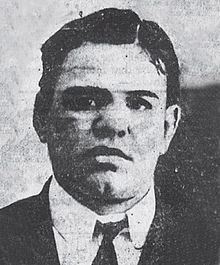
Monk Eastman was 5’6″ and was as tough as any man in the world. In Michael Walsh’s popular book based on the life of Owney Madden, Eastman takes him under his wing and teaches him the ropes. Soon Eastman is beaten so badly that he almost dies in a tenement bed, alone.
In 1917, during a physical, Monk Eastman was asked what wars he had already served in since he had so many knife and gun wounds on his body, “Oh! A lot of little wars around New York.”
There were literally wars happening everywhere in New York and other major cities. Gangs were such a nuisance at the time that there were specific police units that were created to combat against them, like the Strong Arm Squad.
But the police were no match for the gangs of the 1890s and early 1900s Manhattan and Brooklyn. The problem was much bigger than any cop with a blackjack could handle.
Territories were bordered by street names and any gang or gang member that dared cross into a neighborhood that wasn’t their own risked violence.
In Manhattan, street gangs flourished from all the symptoms that creates gangs. There were so many gangs and gangsters that any small business owner didn’t dare open a shop without first paying respect to the local gang.
Paolo Vaccarelli an Italian immigrant also known as Paul Kelly (used this moniker to get into boxing matches when he was young since the incumbent Irish dominated the prize fight racket) paid homage to the Civil War era when he ran a gang called The Five Points Gang. They ruled the area that once was the Five Points in the Lower-mid Manhattan area around what we know now as the Restaurant district “Little Italy” and into Chinatown.
If you were to walk through the incredibly over-populated Lower East Side of the era, you would run across a few members of the Yake Brady Gang, based on the northern end of Cherry Street. Yake Brady himself was probably the brother of Mary Brady, who married a boxer named John Lonergan. Together they had, according to most accounts, fifteen children. Within that brood was the famous one-legged White Hand Gang member of Brooklyn, Richard “Pegleg” Lonergan and the queen of the Brooklyn waterfront, Anna Lonergan.
Also on the Lower East Side were the Swamp Angels, who were known as river pirates along the docks and piers of East Manhattan and Brooklyn. They were based in a horrible set of rowhouses called Gotham Court that dated back to the Civil War. Utilizing the New York sewage system that ran from below Gotham Court to the waterfront, they would steal through them in the middle of the night, take valuable goods of ships tied to the piers and sell them inland.
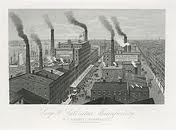
The Babbitt Soap Factory employed many people, but there were a lot more in the neighborhood that needed jobs. Although there were lots of factories and manufacturing jobs in the city, the population well outnumbered the jobs. A flourishing reason for the creation of gangs.
Sometimes the gangs were named after the factories in their neighborhoods, like the Gas House Gang, named for the humungous gas house tanks on 20th Street and 1st Avenue. The Potashes, which were led by Red Shay Meehan (relation to Dinny Meehan? Who knows), were named after the Babbitt soap factory on Washington and Rector streets.
On the West End of Manhattan were a plethora of low-going gangs, including the ever popular Hudson Dusters. They were known as cocaine sniffing wild boys who fought with other gangs for dominance. Members include Goo-Goo Knox, Honey Stewart and Kid Yorke. So tough, they were employed by Tammany Hall as muscle during elections.
The Boodle Gang was another survivor of earlier days. In the 1850s, they raided butcher carts and food wagons that ran through their neighborhood, among other rogue forays.
The Gopher Gang, which fought the Hudson Dusters for supremacy of Hell’s Kitchen and the West Side Manhattan, was led by Owney Madden. Working with Tanner Smith’s gang The Marginals and the Pearl Buttons and the Fashion Plates, they eventually took over the area after Monk Eastman all but disappeared and the Five Points Gang leader Paul Kelly tried a more legitimate lifestyle as a labor leader in the International Longshoreman’s Association (hardly legitimate, but a step above street gangs at least).
Another phenomena was the New York Jewish gangs. Though they weren’t considered gangs like the Irish gangs. They were a little less organized. If the Italians stuck to family loyalties and moral codes like Camorra or the Cosa Nostra, and the Irish were fist-fighting, street-level racketeers, Jewish thugs were out for themselves in the organized crime racket.
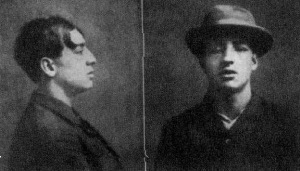
“Dopey” Benny Fein‘s mug shot. He, along with many other Jewish immigrant gangsters fought for the right to provide strike-breakers and other nefarious doings in New York City.
The Labor Slugger Wars, a little known yet wildly interesting collection of tit-for-tat battles among barely legitimate groups of Jewish gangsters is a perfect platform to analyze their lifestyles. Young men with great monikers like “Dopey” Benny Fein, Joe “The Greaser” Rosensweig, Jacob “Little Augie” Orgen and “Kid Dropper” Nathan Kaplan fought for the right to be hired by the unions or companies to kill or maim employees, labor organizers or anyone that presented a problem.
These wars also determined who would provide scabs, or replacement workers when a union strike took place in the Garment District for instance, or a bunch of longshoremen on the docks. It was a duplicitous lifestyle, to say the least, as they were often hired by both sides of competing organizations to get back at the other. They literally benefited from wars, which is still common today, though somehow considered legitimate (see Halliburton and other war mongering companies).
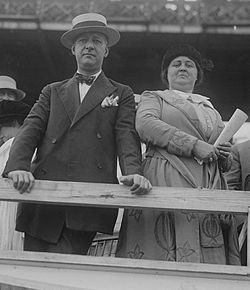
Al Smith with his wife at a baseball game. He brought empathy and street-level toughness to Albany and eventually passed laws that helped the poor.
In summary, gangs were rampant during the Gay Nineties and the early 1900s, and the decline of gangs in the nineteen-teens was due, in part, by the Progressive Era politicians, humanitarians and organizers in New York many years earlier. People like Jacob Riis, the famous photographer and, of course, Al Smith.
Smith grew up working as a youngster in the Lower East Side Fulton Fish Market. Mostly uneducated as a youth, he learned the value of a good work ethic from his father, who died on his way to a polling station to vote. His thick New York City accent didn’t bode well in Albany after he was elected to represent his district there, but through hard work and an extreme amount of charm, he worked his way (almost) to the top. Eventually becoming mayor of New York City, but failing in his bid to represent the Democrats in the 1928 Presidential Election.
Smith represented a new politician. One that wanted to provide for the poor. Give them the chance to succeed too. In Albany, he passed many laws and in my estimation, he and those that followed his lead are more responsible for doing away with gangs than any Strong Arm police squad could ever have done.
Although Prohibition (which Smith was against, of course) allowed organized crime to flourish in the 1920s, by the 1930s and 1940s, street gangs had all but been eradicated due to a social safety net to help the poor get on their feet, feed their children even if they didn’t have a job yet and cast a caring eye toward the downtrodden, particularly after the passing of the New Deal by President Franklin D. Roosevelt.
June 9, 2013
Break for Edit
Sorry I haven’t posted lately folks, I am in an editing stage right now where I have to make final decisions on the book before it goes to the publisher. At that point the editing continues, but just technical editing. No new ideas will be introduced by then. So, this is my last chance to introduce anything into the book.
In the meantime, here is a photo of the Sands Street Station in Brooklyn during the White Hand Gang’s era. It was built around 1908 and torn down in 1944. As you can see, it had many tentacles of tracks coming out from it as it was literally the central station for all Brooklyn travel.
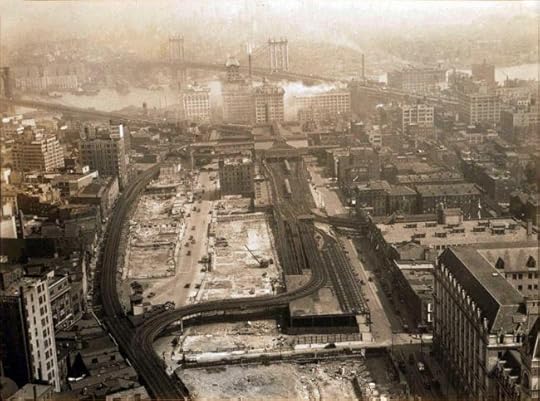
The actual station house is just above the center of the photo, but you can see Fulton Street to the left underneath the elevated track and the Manhattan Bridge at the top of the photo.
Since it was connected to the approach of the Brooklyn Bridge, it allowed Brooklynites to travel to Manhattan by train or trolley and Manhattanites to make a quick stop in Brooklyn, if need be. The station was three levels high and had adjoining tracks on each level that connected to the Fulton Street Elevated track or the Myrtle Avenue Elevated. Before doing so, however, there was a loop that the trains had to go round in order to double back to Brooklyn instead of going over the bridge. From there, you could travel all the way down to Coney Island or various places in Queens or to Prospect Park, if you like.
The White Hand Gang’s newest members, Richie Lonergan and his crew (Petey Behan, Abe Harms, Matty Martin and Timothy Quilty), all around ages 14 and 15, previously pick-pocketed and cut-pursed at the station during the day. Since there were so many travelers and not a huge police presence, the Sands Street Stations was a popular place for muggers.
This humungous, three-level station with elevated tracks running through the tenement neighborhoods and along the waterfront was literally a few blocks away from 25 Bridge Street, a longshoremen’s saloon which was the White Hand Gang’s headquarters.
Eventually, the station and the elevated tracks were torn down and Cadman Plaza was built in this area in a very similar shape.
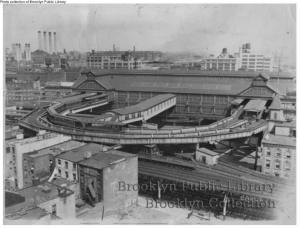
The Loop at the Sands Street Station. I don’t know about you, but that doesn’t seem very stable to me.
Like the Manhattan Bridge (built in 1909), it was not around when the area was called Irishtown, but became a permanent fixture when the Brooklyn waterfront became the industrial and manufacturing center of the United States in the busiest port harbor in the world.
Hope you all are enjoying your weekend and I’ll post something up as soon as I can.
Thanks,
Eamon


May 30, 2013
Fact Sheet
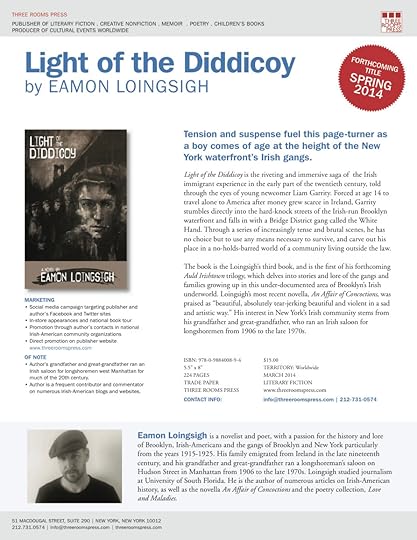
Here’s a great little tool that tells you exactly about the book, when it’ll be published and who the author is.
Great job Peter Carlaftes, Kat Georges and everyone over at Three Rooms Press! Very impressive!







